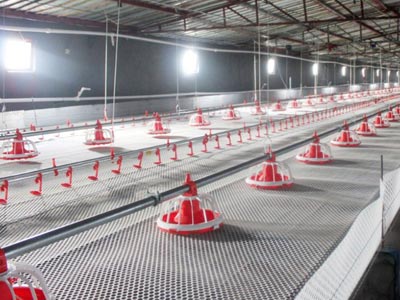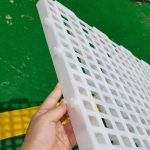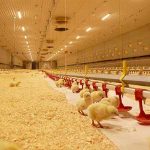Large-scale, fully automatic free range chicken cage technology for laying hens has been widely used in European and American countries. This technology requires chicken houses to be located more than 1 km away from main roads, residential areas and other livestock and poultry breeding areas. The scale of a single house is 50,000 to 100,000. The chicken house adopts a fully enclosed negative pressure ventilation automatic environmental control system. Through automatic real-time monitoring of the temperature and humidity in the house, the temperature is automatically adjusted by the heating system at low temperature, and the working state of wet curtain and fan is automatically adjusted at high temperature. achieve cooling. The automatic control system can automatically control the ventilation and lighting in the house. The height of the screen plate is convenient for the transmission and cleaning system of chicken manure and the setting of the central automatic egg collection system, which can be designed according to the needs of actual production operations. The technology adopts automatic chain feeding, automatic nipple-type drinking, automatic egg-collecting egg box, and automatic conveyor belt for manure removal. There are two stages of nutrient leveling, that is, the brooding stage from 0 weeks to 18 weeks, and the egg laying stage from 19 weeks to 72 weeks.


Brooding and rearing stage (0 weeks to 18 weeks)
For chicks aged 0 to 6 weeks, the room temperature is required to reach 30°C to 32°C in the first week, and the temperature in the second week is 30°C to 32°C. 29°C to 30°C, and then drop by 2°C to 3°C every week depending on the specific situation. Under well-ventilated conditions, the optimal relative humidity can be controlled at 40% to 72%. When using a free range chicken cage for flat brooding, the mesh size requirements for the stencil are (0.5 to 1.0) square centimeters x (0.5 to 1.0) square centimeters. The stocking density of 0 to 6 weeks old online is 13 to 15 per square meter, and the 7 to 18 week old is 8 to 10 per square meter. A constant light system is adopted in the closed house, that is, 23 hours to 24 hours within 3 days or 1 week after the chicks hatch, and 8 hours to 9 hours for 2 weeks to 18 weeks of age. The intensity is 20 lux (that is, 3 watts to 4 watts per square meter watts), 5 lux (ie 2 watts per square meter) between 2 and 18 weeks of age. The pans and drinkers are positioned so that all chickens can eat and drink at the same time.
Specification of free range chicken cage
| Slat foor | ||||
| Type | Unit | Size/mm | Mesh/mm | Weight/kg |
| 1 | pcs | 1200*500*40 | 16*16 (for baby chicken) | 2.0 |
| 2 | pcs | 1200*500*40 | 20*20 | 2.0 |
| 3 | pcs | 1200*500*40 | 20*24 | 2.3 |
| 4 | pcs | 1200*500*40 | 18*40 | 1.65 |
| Base | Made of PVC, the height is adjustable from 280mm to 500mm |
| Beam | Height(material): 9cm(PVC)/12cm(PVC)/15cm(FRP); |
| Length: 3/4 m | |
| Tube | Diameter: 5cm, made of PVC |
Feeding restriction in free range chicken cage
Restricting the amount of food intake (quantity restriction), the quantity restriction can take a variety of methods: quantitative feeding restriction, combination of feeding stop, restricting feeding time, and stopping feeding for a certain period of time; the second is to restrict the nutritional level of the diet (qualitative restriction ), limiting nutrient levels is to reduce the content of crude protein and metabolizable energy in the diet, and at the same time, also reduce the ratio of protein to energy, and other trace elements in the diet must be guaranteed, so as not to affect the development of skeletal muscle. After mass restriction, the crude protein in the diet of 7-14-week-old chickens is generally 15%, the metabolizable energy is 1149 kJ per kilogram of the diet, and the protein in the diet of 15- to 18-week-old chickens is 12%. The metabolizable energy was 1286 kJ per kilogram of diet. Before the feeding restriction, the sick chickens and weak chickens should be picked out to avoid increasing the number of deaths during the feeding restriction; sufficient water troughs and food troughs should be provided, and the material should be spread evenly, so that each chicken has a slot for the chickens to eat. Synchronization; every 1 to 2 weeks (usually every other week), 2% to 5% of the chickens are randomly selected for fasting weighing at a fixed time. If the body weight exceeds 1% of the standard weight, it will be A total of 1% of the real feed amount is subtracted in the week, and the feed is increased by 1% if the body weight is 1% lower than the standard weight. Feeding restriction starts from 8 weeks old to 12 weeks old and ends at 18 weeks old before transfer to the group. During feed restriction, feed nutrient levels and feed amounts should be adjusted according to body weight and development. At the age of 18 weeks, the chickens should be transferred to the laying house. Note that feeding should be stopped 6 hours before the transfer, and 1 to 2 times the normal amount of vitamins should be added to the drinking water 3 days before and 3 days after the transfer. Drink an electrolyte solution to reduce the stress response caused by the group transfer. On the day of the transfer group, there was continuous light for 24 hours to ensure food intake and drinking water. Reduce stress in other areas, reduce the temperature difference between the two houses, do not perform beak cutting and preventive injections at the same time, use transitional feed changes, and provide sufficient feed and drinking water at the same time. At the same time when the group is transferred, sick chickens, weak chickens, underweight and stunted chickens can be selected and eliminated to prevent them from being transferred to the laying hen house.



